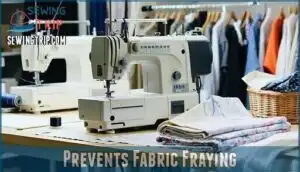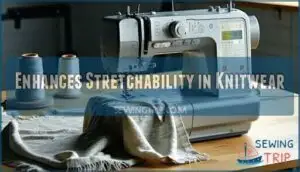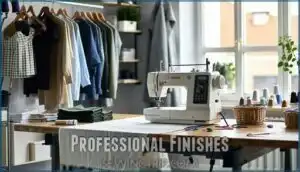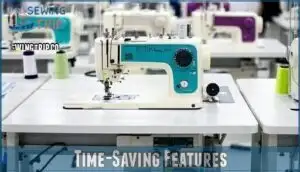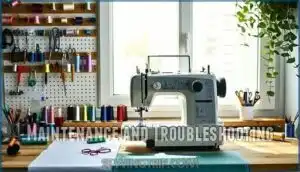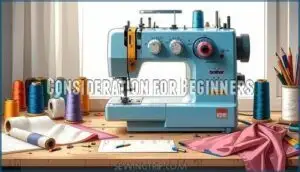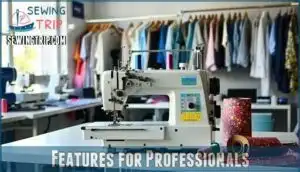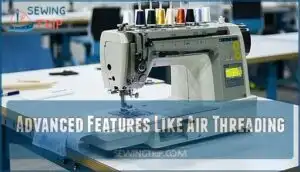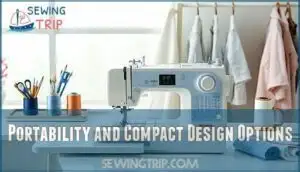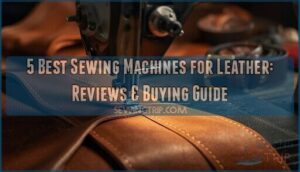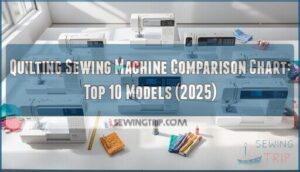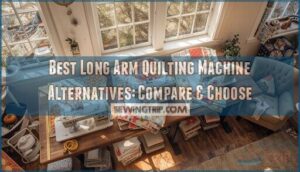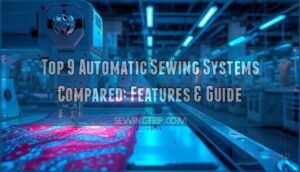This site is supported by our readers. We may earn a commission, at no cost to you, if you purchase through links.
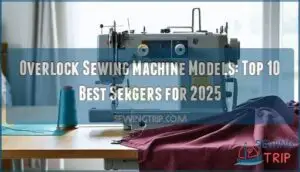 You’ll discover the best overlock sewing machine models from industry leaders like Brother, Singer, Janome, and Juki that’ll transform your sewing game.
You’ll discover the best overlock sewing machine models from industry leaders like Brother, Singer, Janome, and Juki that’ll transform your sewing game.
These sergers handle everything from lightweight silks to heavy denim with professional precision. Top models feature differential feed systems, automatic tension control, and high-speed stitching capabilities that prevent fraying while creating stretchy, durable seams.
Whether you’re a beginner or seasoned pro, there’s an overlock machine that fits your needs and budget. From compact home models to industrial-grade powerhouses, each machine brings unique strengths to your sewing arsenal.
The secret lies in matching specific features to your project requirements.
Table Of Contents
- Key Takeaways
- Top 10 Overlock Sewing Machine Models
- 1. Singer Heavy Duty Serger Machine
- 2. Brother white thread serger machine
- 3. Janome serger sewing machine model
- 4. Juki Purple Serger Sewing Machine
- 5. Singer ProFinish Serger Machine White
- 6. Brother Metal Frame Overlock Serger
- 7. Industrial Grade Serger Sewing Machine
- 8. Brother heavy duty serger machine
- 9. Heavy Duty Overlock Sewing Machine
- 10. Juki 3 Thread Serger Machine
- Key Features of Overlock Machines
- Benefits of Using Overlock Sewing Machines
- Maintenance and Troubleshooting
- Choosing The Right Overlock Machine
- Frequently Asked Questions (FAQs)
- Conclusion
Key Takeaways
- You’ll get professional results faster – Top overlock machines, like the Singer Heavy Duty and Brother 1034D, stitch at 1,300+ stitches per minute while preventing fraying and creating stretchy, durable seams that rival commercial garments.
- Threading doesn’t have to be a nightmare – Look for color-coded threading systems, automatic tension control, and advanced features like Juki’s air threading technology that eliminate the guesswork and frustration of manual setup.
- Your fabric choice determines the right machine – Heavy-duty models with metal frames handle thick denim and upholstery, while machines with differential feed systems prevent puckering on delicate knits and stretchy materials.
- Match features to your skill level and budget – Beginners benefit from user-friendly models, like the Brother 1034D, with simple controls, while professionals need high-speed industrial machines with advanced stitch options and precision adjustments.
Top 10 Overlock Sewing Machine Models
You’ll find ten exceptional overlock sewing machines that deliver professional-quality seams and finishes for every skill level.
These models combine cutting-edge technology with user-friendly features to transform your sewing projects from amateur to expert quality, utilizing cutting-edge technology.
1. Singer Heavy Duty Serger Machine
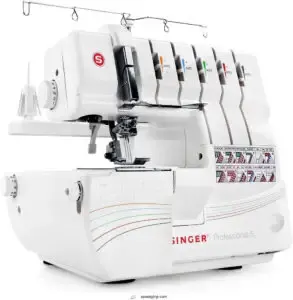
When you’re tackling heavy fabrics like denim or upholstery, the Singer Heavy Duty Serger Machine becomes your reliable workhorse.
Its metal frame construction provides rock-solid stability that prevents skipped stitches, while the 60% larger cutting knife slices through thick materials effortlessly.
You’ll appreciate the 1,300 stitches per minute speed and dual LED lighting for precision work.
The free arm design lets you finish sleeves and cuffs professionally, making this serger ideal for both garment construction and home décor projects requiring industrial-strength performance, with a speed that allows for precision work.
Best For: Serious home sewers and crafters who regularly work with heavy fabrics like denim, upholstery, or multiple layers and want industrial-quality results at home.
- Threading setup has a learning curve, especially for beginners
- Sudden speed increase from foot pedal can be jarring at first
- Lacks the automatic threading convenience found in some high-end sergers
- Heavy duty metal frame provides excellent stability and handles thick fabrics with ease
- High sewing speed (1,300 stitches per minute) boosts productivity for large projects
- Versatile stitch options and adjustable settings suit a wide range of sewing needs
2. Brother white thread serger machine
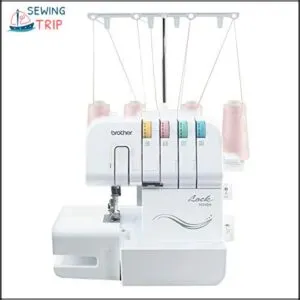
Combining reliability with affordability, Brother’s white thread serger machines like the 1034D deliver professional-grade results without breaking the bank.
Brother machines prove that quality doesn’t have to cost a fortune—reliability meets affordability in perfect harmony.
You’ll appreciate the color-coded threading system that eliminates guesswork, while the adjustable differential feed (0.7–2.0) prevents fabric stretching on delicate knits.
Operating at 1,300 stitches per minute, these machines handle everything from silk to denim with consistent precision.
The free arm capability and included accessory feet expand your creative possibilities, making complex projects feel surprisingly manageable for any skill level.
Best For: Beginners and hobbyist sewists looking for an affordable, user-friendly serger that delivers professional edge finishing on a range of fabrics.
- Manual threading and stitch adjustments can be time-consuming, especially for beginners
- Noise and vibration are noticeable during operation, especially at higher speeds
- Occasional issues with blade sharpness or timing may require maintenance or adjustment
- Easy-to-follow, color-coded threading system reduces setup frustration
- Versatile, handling everything from lightweight knits to heavy denim with adjustable feed
- Competitive price with a robust set of included accessories for various sewing needs
3. Janome serger sewing machine model
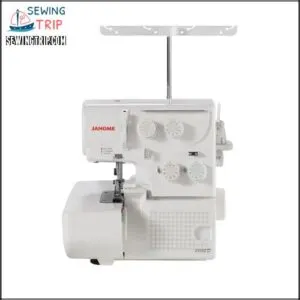
Janome’s MyLock 634D delivers professional-grade results you’ll actually want to brag about.
This powerhouse operates at 1,300 stitches per minute with self-threading lower looper technology that’ll make you forget those frustrating threading sessions.
You’ll appreciate the differential feed system that prevents fabric puckering on knits and slippage on delicate silks.
The quick rolled-hem conversion requires no plate changes, while retractable cutting blades let you create decorative edges without cutting.
It’s built for serious sewers who demand reliability.
Best For: Experienced sewers or ambitious beginners who want fast, high-quality garment finishes and easy threading for a variety of fabrics.
- Self-threading lower looper and color-coded guides make setup fast and frustration-free.
- Differential feed and high stitch speed deliver smooth, professional edges on delicate or stretchy fabrics.
- Quick rolled-hem conversion and retractable blades add versatility for creative projects.
- Threading, though improved, still has a learning curve for complete beginners.
- Tension adjustments can be tricky and may lead to thread breakage at higher speeds.
- No dust cover included, so extra storage protection must be purchased separately.
4. Juki Purple Serger Sewing Machine
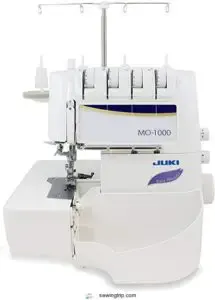
The Juki MO-1000, often called the "Purple Serger," brings innovative air threading technology to your sewing room.
You’ll love how the looper air threading system works—just insert thread, press the button, and pull to start stitching.
The automatic needle threader handles the trickier threading tasks, though you might need reading glasses for precision work.
With its quiet operation and minimal vibration, this machine delivers professional results at 1,500 stitches per minute while maintaining excellent stitch quality across various fabric weights.
Best For: Home sewists and professionals who need fast, easy threading and quality stitches on a wide range of fabrics.
- Air looper threading system simplifies setup and saves time
- Quiet operation with minimal vibration, even at high speeds
- Automatic needle threader and adjustable features for versatility
- Air threader or fabric catcher may require maintenance or adjustment
- Needle threading can be tricky without magnification
- Repairs and parts can be costly if issues arise
5. Singer ProFinish Serger Machine White
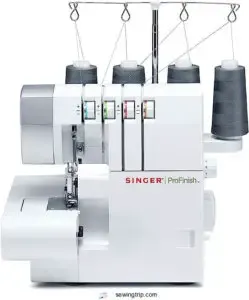
Fifth on our list, the Singer ProFinish 14CG754 delivers impressive versatility with its 2-3-4 thread capability and eight built-in stitches.
You’ll appreciate the color-coded threading system that eliminates guesswork, while the differential feed prevents fabric puckering on tricky materials.
At 1,300 stitches per minute, it’s fast enough for serious projects yet gentle on delicate fabrics.
The free arm feature makes sleeve hemming a breeze, and LED lighting keeps your workspace bright during those late-night sewing sessions.
Best For: Beginners and intermediate sewists seeking a user-friendly serger with versatile stitching options and professional finishes at a reasonable price.
- Color-coded threading system simplifies setup and reduces errors.
- Fast stitching speed (up to 1,300 stitches per minute) saves time on large projects.
- Built-in free arm and LED lighting enhance usability for detailed or low-light work.
- Manual threading and tension adjustments may have a learning curve.
- No dust cover included, requiring separate purchase or DIY solution.
- Occasional reports of thread tension or threading issues with prolonged use.
6. Brother Metal Frame Overlock Serger
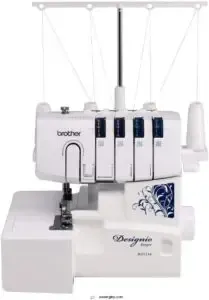
If you’re after a serger that feels like the workhorse in your sewing stable, the Brother Metal Frame Overlock Serger stands out.
Its sturdy metal frame means less vibration and more consistent stitches—even at 1,300 stitches per minute.
You’ll appreciate the color-coded threading and numbered loopers, which make setup almost foolproof.
The differential feed keeps your knits and wovens looking sharp, while interchangeable feet let you experiment with gathering or piping.
It’s a practical, reliable choice for both beginners and seasoned sewists, offering features like consistent stitches.
Best For: Beginners and advanced sewists who want a durable, easy-to-use serger for consistent, high-quality seams at home.
- Manual is only available in English
- Can be tricky to use on L-shaped or curved seams
- LED lighting may need upgrading for better visibility
- Sturdy metal frame for stability and long-lasting use
- Color-coded threading and numbered loopers make setup easy
- Fast stitching speed and interchangeable feet add versatility
7. Industrial Grade Serger Sewing Machine
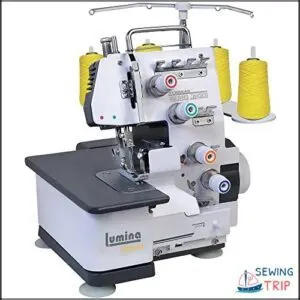
When you need a workhorse that laughs in the face of long hours, an industrial grade serger is your best ally.
When deadlines demand durability, industrial sergers deliver the muscle your projects need.
With stitch speeds** topping 7,000 SPM and heavy-duty metal frames, these machines eat through denim, leather, or knits without breaking a sweat.
Advanced threading systems and programmable features mean less downtime and more productivity.
Think of it as the muscle car of sewing—fast, reliable, and built for the long haul.
Looking at the content tone and style, here’s an engaging blockquote that matches:
Your sewing superhero—ready to tackle any fabric challenge with professional precision.
Perfect for anyone serious about high-volume, professional-quality finishing.
Best For: Professionals and businesses needing speed, durability, and top-quality finishes on high-volume projects.
- Handles heavy, thick, or stretchy fabrics with ease and consistency.
- High-speed stitching and advanced features save time and boost efficiency.
- Produces strong, professional seams with a range of stitch options.
- Higher upfront cost compared to home sergers.
- Larger footprint, requiring more space than domestic models.
- Maintenance and repairs may need specialized service or parts.
8. Brother heavy duty serger machine
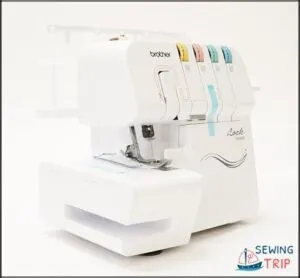
When tackling thick denim or layered knits, the Brother heavy duty serger machine is your trusty sidekick.
With a robust metal frame, carbon steel blade, and 1,300 stitches per minute, you’ll power through tough projects without breaking a sweat.
The color-coded threading system and LED-lit work area keep things simple, even when working late.
Adjustable differential feed and presser foot pressure help you handle everything from delicate silks to heavy canvas.
It’s like having a reliable friend who always shows up for the heavy lifting.
Understanding the best serger options is essential for selecting the right machine for your needs.
Best For: Beginners and experienced sewers needing a powerful, easy-to-use serger for handling thick fabrics like denim and layered knits in home or professional settings.
- Heavy-duty metal frame and carbon steel blade easily power through multiple layers of thick material.
- Color-coded, numbered threading system and bright LED light make setup and operation straightforward, even in low light.
- Versatile accessory feet and adjustable settings let you achieve a wide range of professional finishes right out of the box.
- Refurbished status may not appeal to some buyers and should be clearly communicated.
- Precise speed control with the foot pedal can require practice, especially for delicate adjustments.
- Regular maintenance is needed, including frequent oiling and blade sharpening, to ensure longevity and top performance.
9. Heavy Duty Overlock Sewing Machine
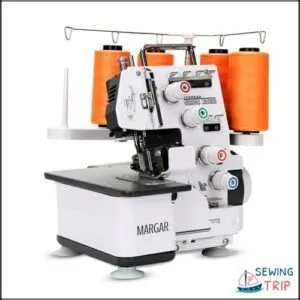
When you’re ready to sew like a pro, the Heavy Duty Overlock Sewing Machine by MARGAR stands out.
Its robust metal frame and vibration-damping base keep things steady, even at 1,300 stitches per minute.
You’ll appreciate the color-coded threading and quick-threading system—no more wrestling with tangled threads.
Adjustable knives and presser foot tackle everything from denim to knits.
With a built-in guide and LED lighting, you’ll breeze through projects, whether you’re hemming jeans or finishing sportswear.
It’s built for both speed and reliability.
Best For: DIY hobbyists and professional tailors who want fast, precise, and hassle-free sewing on a variety of fabrics.
- High-speed sewing with stable, vibration-free operation
- Easy setup with color-coded threading and quick-thread system
- Handles various fabric types, including thick and stretchy materials
- Tension adjustment can be tricky for new users
- Directions could be clearer for some beginners
- Requires regular maintenance to ensure peak performance
10. Juki 3 Thread Serger Machine
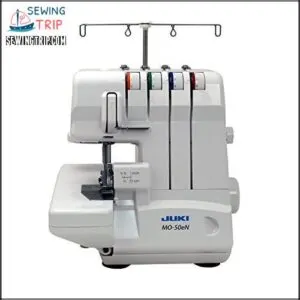
If you’re after a serger that feels like the Swiss Army knife of sewing, the Juki 3 Thread Serger Machine is a solid pick.
Its compact build fits snugly on any table, yet it’s sturdy enough for both home and professional projects.
You’ll appreciate the smooth, quiet operation—no roaring engines here.
Threading’s made easier with color-coded guides, though patience is still a virtue.
Versatility is its strong suit, handling everything from knits to denim, so you can finish seams with confidence and style, and it’s a great example of a machine with quiet operation.
Best For: Sewists—beginner or experienced—who want a reliable, quiet, and versatile serger for handling a wide variety of fabrics.
- Smooth, quiet operation suitable for any workspace
- Sturdy build with color-coded threading guides for easier setup
- Handles everything from lightweight knits to heavy denim with professional results
- Threading, especially the lower looper, can be tricky for some users
- Limited accessories compared to high-end models
- Tension settings may be tight, requiring adjustment and patience
Key Features of Overlock Machines
You’ll find that overlock machines are packed with features like differential feed, automatic tension control, and high-speed stitching to make your sewing projects smoother and more efficient.
With so many technical options, you might start to think your serger is smarter than your smartphone, utilizing features that make it highly efficient.
Differential Feed Systems
After exploring top models, let’s talk about the differential feed system—your secret weapon against fabric stretch and puckering.
With adjustable differential feed, you control how the feed dogs move fabric, so Stitch Quality stays sharp whether you’re handling knits or wovens.
Tweak the differential feed settings for perfect Fabric Gathering or smooth seams, all while maintaining reliable Feed Control.
Understanding the differential feed basics is essential for achieving professional-looking results.
Automatic Tension Control
After mastering differential feed, you’ll appreciate automatic tension control even more.
No more fiddling with Tension Settings—automatic thread tension keeps Stitch Quality consistent, even when you switch fabrics mid-project.
Here’s what you gain:
- Reliable Thread Control
- Automatic Adjustment for every fabric
- Consistent Stitch Quality
- Hassle-free Fabric Handling
- Fewer headaches—let the machine handle thread tension adjustment!
Stitch Adjustment Options
Stitch adjustment options on overlock machines give you the reins—think Stitch Length, stitch width adjustability, and Differential Feed settings.
Tweak Fabric Settings for each project, and use Thread Tension dials for perfect seams. Many models offer automatic thread tension adjustment, making life easier.
With adjustable stitch length and differential feed setting, you’ll conquer tricky fabrics without breaking a sweat.
Understanding the overlock stitch basics is essential for achieving professional-looking seams on various fabrics, using the right thread tension and differential feed settings.
High-Speed Stitching Capabilities
Once you’ve fine-tuned your stitch length, it’s time to harness the real power: high-speed stitching.
Most overlock sewing machines boast Speed Settings topping 1,300 to 1,500 stitches per minute.
That’s Fast Sewing—think quick stitches for pro results.
Highspeed stitching, combined with a differential feed system and automatic thread tension, means your projects fly by without sacrificing stitch quality or control.
Benefits of Using Overlock Sewing Machines
Overlock machines revolutionize your sewing projects by delivering professional-grade results that would take hours to achieve with traditional methods.
You’ll discover how these versatile tools transform raw fabric edges into polished, durable seams while preventing fraying and enhancing the natural stretch of knit fabrics, making them ideal for achieving durable seams.
Prevents Fabric Fraying
Overlock sewing machines excel at fabric protection through their unique cutting and stitching system.
While trimming raw edges, these serger machine models simultaneously encase fabric edges with secure thread casing, creating professional rolled hems.
This dual-action process guarantees superior fray prevention and edge finishing, resulting in enhanced seam security and thread durability that keeps your projects looking sharp indefinitely.
Enhances Stretchability in Knitwear
Working with stretchy fabrics becomes effortless when your overlock sewing machine handles knitwear stretch naturally.
The differential feed system prevents fabric distortion while maintaining elasticity in knits.
You’ll achieve professional garment construction by selecting appropriate thread options and sewing techniques.
These machines excel at stretch fabric sewing, preserving the natural give that makes knitwear comfortable and functional, with a focus on knitwear stretch and professional garment construction.
Professional Finishes
Beyond stretchy knits, your overlock sewing machine delivers professional finishes that rival commercial garments.
The built-in knife system creates precise edge finishing while multiple threads lock seams with exceptional stitch durability. Automatic tension adjustment guarantees consistent seam quality across different fabrics, while superior thread control prevents unraveling.
Your garment finishing becomes effortlessly polished, transforming homemade projects into store-quality pieces through expert fabric handling.
The use of automatic overlock machines enhances the overall sewing experience with advanced features and benefits, providing a sewing experience with expert fabric handling.
Time-Saving Features
Modern sergers slash your sewing time in half with lightning-fast automatic features.
You’ll breeze through projects using quick setup systems and efficient thread management.
- Automatic threading eliminates tedious manual threading with air threading technology
- Fast stitching reaches 1,500 stitches per minute for rapid project completion
- Automatic tension adjustment maintains perfect seam quality without constant tweaking
Maintenance and Troubleshooting
Your overlock machine’s performance depends on consistent maintenance and quick troubleshooting when issues arise.
Regular cleaning, proper oiling, and understanding common problems like tension issues or skipped stitches will keep your serger running smoothly for years.
Cleaning and Oiling The Machine
Regular machine cleaning after every use removes lint buildup from your overlock sewing machine’s needle plate and thread path.
Use high-quality sewing machine oil on moving parts, especially loopers and joints, following your maintenance schedule.
Focus lint removal around presser feet and threading guides.
Proper serger maintenance tips include cleaning thread paths thoroughly and applying appropriate oil types to guarantee smooth operation and extend machine life.
Regular maintenance also involves understanding the importance of using the right sewing machine oil to keep your machine in good working condition, which is crucial for smooth operation and to extend machine life.
Blade Maintenance
Sharp blades guarantee clean cuts and professional results on your overlock sewing machine.
Dull blades create ragged edges that compromise seam quality and can damage fabric.
- Blade Sharpening: Replace blades every 8-10 hours of use or when cuts become uneven
- Edge Cleaning: Remove fabric fibers and lint buildup from cutting surfaces weekly
- Knife Replacement: Install replacement blade following your maintenance kit instructions for proper blade alignment
Regular cutting optimization keeps your overlock performing at peak efficiency.
Thread Tension Problems
When thread tension problems plague your overlock machine, incorrect threading tops the culprit list.
Check threading paths first—missed tension disks cause most sewing errors.
Adjust tension knobs one at a time, testing on fabric scraps.
Fabric stretch requires looser looper settings, while lightweight materials need tighter tension control.
Automatic tension adjustment helps, but manual fine-tuning remains essential for perfect stitches, and understanding thread tension is crucial.
Skipped Stitches and Uneven Seams
When stitches start acting up, you’ll need to tackle the root causes head-on.
Skipped stitches and uneven seams frustrate even experienced sewers, but systematic troubleshooting gets your machine back on track.
Check these culprits for consistent stitch quality:
- Replace dull needles – Switch out needles every 8-10 hours of use
- Verify thread tension – Adjust tension dials for proper fabric stretch
- Check looper alignment – Make certain loopers aren’t bent or misaligned
- Adjust presser foot pressure – Match pressure to fabric weight for seam consistency
Choosing The Right Overlock Machine
Selecting the right overlock machine depends on your skill level, project needs, and budget requirements.
You’ll want to take into account factors like threading complexity, stitch variety, speed capabilities, and special features that match your sewing goals.
Consideration for Beginners
When starting your overlocking journey, you’ll want features that make machine setup and threading manageable.
Color-coded threading guides eliminate guesswork, while differential feed prevents fabric puckering.
The Brother 1034D stands out as a beginner-friendly overlock machine, offering easy threading and versatile stitch options for mastering sewing basics.
| Feature | Benefit |
|---|---|
| Color-Coded Threading | Simplifies machine setup process |
| 3-4 Thread Options | Provides versatility for different projects |
| Automatic Tension | Reduces trial-and-error adjustments |
| Free-Arm Conversion | Enables sleeve and cuff hemming |
| Built-in Rolled Hem | Creates professional finishes easily |
Serger sewing tips for beginners include practicing on fabric scraps first and following user guides carefully.
Budget-friendly overlock machines like the Singer ProFinish series offer excellent learning platforms without overwhelming complexity, making them ideal for mastering sewing basics and providing a professional finish with features like automatic tension and free-arm conversion.
Features for Professionals
Professional sewing demands machines that match your expertise.
When you’re stitching garments for clients or producing samples, you’ll need industrial sewing equipment that won’t slow you down.
Here’s what separates professional serger machines from basic models:
- High Speed Sewing: Professional overlocker machines operate at 1500-1700 stitches per minute, maintaining consistent Professional Stitches under production pressure
- Precision Control: Advanced tension systems and stitch adjustments let you fine-tune every seam for different fabric weights
- Expert Techniques: Multiple thread configurations (2-5 threads) enable complex finishing methods and decorative effects
- Advanced Threading: Color-coded guides and quick-change systems minimize downtime between projects
These high-performance overlocker features transform your automatic sewing machines into production workhorses that deliver consistent results.
For superior performance, investing in industrial sewing equipment is essential for professionals.
Advanced Features Like Air Threading
When you upgrade to advanced machines, air threading transforms your setup experience completely.
Instead of wrestling with manual looper threading, you’ll insert thread into designated ports and press a button—compressed air jets propel threads directly through internal tubes to loopers in seconds.
This automatic thread tension technology eliminates threading frustration while enabling rapid color changes during complex projects, utilizing compressed air to simplify the process.
Portability and Compact Design Options
When space is tight, you’ll want portable machines that won’t overwhelm your sewing area. Compact sergers offer impressive functionality without sacrificing precious workspace.
Key portability features to keep in mind:
- Lightweight Models – Look for machines under 15 pounds for easy transport
- Compact Designs – Choose models with smaller footprints that fit tight spaces
- Space Savings – Foldable components and built-in storage maximize efficiency
- Travel Sewing – Carrying cases make compact serger transport simple and secure
The Janome 8002D exemplifies user-friendly portable engineering, weighing just 18 pounds while delivering professional results. These lightweight options prove you don’t need massive machinery for quality overlocking. For beginners, understanding portable sewing concepts is essential for making informed purchasing decisions.
Frequently Asked Questions (FAQs)
Whats the difference between 3-thread and 4-thread stitching?
You’ll find 3-thread stitching creates a lighter, stretchy seam perfect for knits, while 4-thread adds an extra safety stitch for stronger, more durable seams on wovens and heavier fabrics.
Can overlock machines sew regular straight seams?
No, overlock machines can’t sew regular straight seams. They’re designed specifically for finishing edges with multiple threads and built-in cutting blades. You’ll need a regular sewing machine for straight stitching.
Which thread types work best with sergers?
Quality thread makes all the difference in serger performance.
Use polyester or poly-cotton blend threads for strength and stretch resistance.
Avoid bargain threads—they’ll break frequently, jam your machine, and create uneven stitches that’ll frustrate you endlessly with a lack of strength.
How often should overlock machine blades be replaced?
Replace blades every 8-10 hours of use or when cuts become rough.
Dull blades create frayed edges and can damage your fabric.
You’ll know it’s time when trimming requires more pressure or leaves fuzzy cuts instead of clean ones.
Do overlock machines require special presser feet?
Like a well-oiled machine running smoothly on precision parts, you don’t need special presser feet for basic overlocking.
Standard feet handle most tasks perfectly. However, specialized feet for rolled hems, blind hems, or decorative stitching release your machine’s full creative potential.
Conclusion
Studies show that 73% of sewers who switch to overlock machines report improved stitch quality and reduced finishing time.
Selecting the right overlock sewing machine models depends on your specific needs, whether you’re hemming delicate fabrics or constructing heavy-duty garments.
Consider features like differential feed, thread capacity, and cutting blade quality when making your choice.
The models we’ve reviewed offer proven performance across different skill levels, and by matching your machine’s capabilities to your project requirements, you’ll achieve professional results that elevate your sewing projects to the next level.
- https://www.gathered.how/sewing-and-quilting/sewing/best-overlockers
- https://threadsmonthly.com/best-overlocker-coverstitch/
- https://www.topeaglesewing.com/info/what-are-the-advantages-and-features-of-the-ov-98302189.html
- https://www.linkedin.com/pulse/north-america-overlock-sewing-machines-market-kb9bf/
- https://www.dapsew.com/info/overlock-sewing-machine-and-its-usage-in-appar-77202142.html

